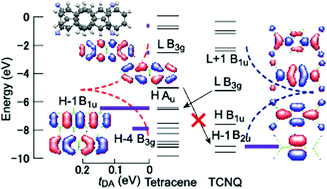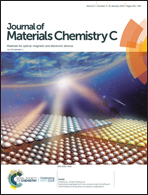Asymmetrical hole/electron transport in donor–acceptor mixed-stack cocrystals†
Abstract
Effective hole and electron transfer of various mixed-stack donor–acceptor cocrystals is investigated on the basis of the partition theory, and it is explained why most of these cocrystals, particularly tetracyanoquinodimethane (TCNQ) complexes, show only electron transport in the transistors. The lowest unoccupied molecular orbital (LUMO) of TCNQ has a stripe symmetry, but the highest occupied molecular orbitals (HOMOs) of acenes, phenes, and thienoacenes have a horizontal node, and the intermolecular transfer between these approximately orthogonal orbitals is very small. However, the next HOMOs of these donors have the same symmetry as the TCNQ LUMO to mediate the electron transport. Electron transport is a universal rule, but it is violated when the molecules are largely tilted or when lower symmetry molecules such as dimethyldicyanoquinonediimine are used instead of TCNQ, where ambipolar transport is observed. Even in this case, cancellation by the second bridge orbital restores monopolar transport as exemplified by the complicated temperature dependence of (anthracene)(TCNQ) transistors. Owing to the small energy intervals of the occupied levels and many node structures of the unoccupied levels, unoccupied orbitals do not work well as bridge orbitals, and pure hole-only transport is unlikely in DA crystals. We, however, show experimental results on the quaterthiophene (4T) complex of TCNQ, which exceptionally exhibits hole transport.

- This article is part of the themed collection: 10th Anniversary: Dedicated Authors


 Please wait while we load your content...
Please wait while we load your content...